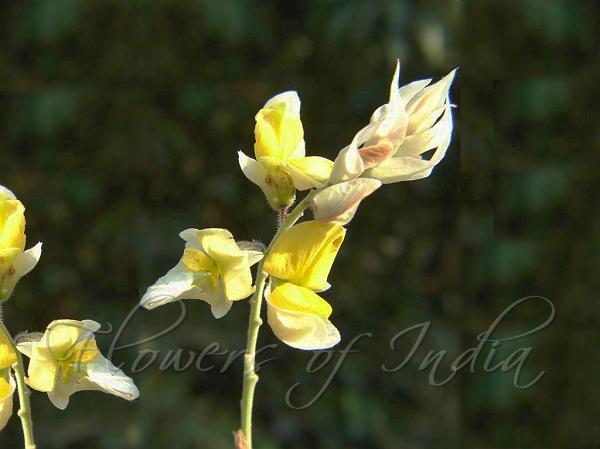|
| Indian Husk-Pea |
|

|

| File size | 132216 |
| Original date | 1/9/07 4:25 PM |
| Resolution | 548 x 768 |
| Flash | Flash did not fire, auto |
| Focal length | 6.0mm |
| Exposure time | 1/100s |
| Aperture | 4.0 |
| Focus Distance | |
| Metering Mode | Multi-segment |
| Camera make | SONY |
| Camera model | DSC-H1 |
| Sensor type |
|
|
|
Photo: |
Botanical name: Paracalyx scariosus Family: Fabaceae (Bean family)
Synonyms: Cylista scariosa
Synonyms: Cylista scariosa
Indian Husk-Pea is a climbing shrub which can grow up to a height of 2-5 meters.
Flowers occur in 10-15 cm long panicles
arising out of leaf axils. Sepal tube is greenish white, husk-like,
boat-shaped. The yellow pea-like flower is concealed beneath it.
It has a woody stem and hairy, twinning branches. Leaves are divided into
three leaflets. Leaflets are about 5-10 cm long. The terminal leaflet is
rhomboid, and bigger than the others. Indian Husk-Pea is found in
India, Bangladesh, Myanmar, Nepal, Thailand.
Flowering: November-February.
Medicinal uses: Indian Husk-Pea is used in epilepsy and to induce sleep.
The fruit is acrid and bitter, improves taste, appetizer, and astringent to the bowels.
The plant enriches the blood, cures biliousness, liver disorders and “kapha”.
It is good for throat troubles, causes flatulence. The root is useful for
treating dysentery and leucorrhoea and also applied externally
along with other drugs to reduce tumors.
Indian Husk-Pea is used in epilepsy and to induce sleep.
The fruit is acrid and bitter, improves taste, appetizer, and astringent to the bowels.
The plant enriches the blood, cures biliousness, liver disorders and “kapha”.
It is good for throat troubles, causes flatulence. The root is useful for
treating dysentery and leucorrhoea and also applied externally
along with other drugs to reduce tumors.
Medicinal uses:
 Indian Husk-Pea is used in epilepsy and to induce sleep.
The fruit is acrid and bitter, improves taste, appetizer, and astringent to the bowels.
The plant enriches the blood, cures biliousness, liver disorders and “kapha”.
It is good for throat troubles, causes flatulence. The root is useful for
treating dysentery and leucorrhoea and also applied externally
along with other drugs to reduce tumors.
Indian Husk-Pea is used in epilepsy and to induce sleep.
The fruit is acrid and bitter, improves taste, appetizer, and astringent to the bowels.
The plant enriches the blood, cures biliousness, liver disorders and “kapha”.
It is good for throat troubles, causes flatulence. The root is useful for
treating dysentery and leucorrhoea and also applied externally
along with other drugs to reduce tumors.
| Identification credit: Pravin Kawale | Photographed in Maharashtra. |
• Is this flower misidentified? If yes,